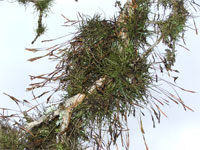Native Plant Road Trip
Ball Moss in La Grange
Hopped in a friend’s car and headed down Hwy 71 to a little town called Fayetteville (about halfway between Austin and Houston) to visit some family and check out the local Czech bakeries that draw people like mistflower draws Monarchs. Even munching on an apricot kolache as I write this…. How am I ever going to get the sticky stuff off the keyboard?
Breezed over into La Grange to see the sights and make the pilgrimage up Gorilla Mountain, nicknamed for the gorilla statue beside the road that stays covered with seasonal decorations. Took a hard right near the bottom and went down some lonesome road that snaked its way through mysterious tunnels created by epiphyte-draped, low-hanging trees. Clumps of ball moss (Tillandsia recurvata) and sheets of Spanish moss (T. usneoides) fill the trees, creating an ambiance not unlike the coastal swamps a few hundred miles away. Some of the oaks support colonies of shield-sorus fern, forming thick, spongy layers upon the stems, which in turn, serve as incubation sites for other epiphytic organisms. This kind of ecology usually inhabits wet tropic forests much farther south, from eastern Mexico down to the rain forests of South America, but Mother Nature has provided a tantalizing taste of the tropics right here in Texas.
Ball moss seems to cause great concern for some people, primarily because they mistakenly think that it is some sort of parasitic plant that has invaded Texas and kills trees. (I think this perception may have formed when oak wilt disease ravaged many live oaks in Central Texas, leaving thousands of dead trees full of ball moss in its wake.) First and foremost, it is an epiphyte, not a parasite. Epiphytes are plants that live on other things (on hosts, usually trees, but often on telephone poles, roofs, road signs, etc.) but do not sink roots into the host plant or harm it in any way. Parasitic plants (mistletoe, dodder, etc.) actually sink specialized roots into the host plant and draw out nutrients to the detriment of the host. Secondly, ball moss is indeed native to Texas. Third, ball moss is a fun and friendly plant, related to pineapples and bromeliads.
Amazingly adaptable, ball moss can thrive in areas of heavy annual rainfall as well as dry areas of the Texas Hill Country. It does this by going dormant in times of drought, during which it will turn gray and look quite dead. A day or two of rain will bring it back to life, and it will resume its normal dark green color and may well develop its lovely, though tiny, blue flowers.
You may be wondering how I could have passed up the native hollies with this December article, since they are looking resplendent and festive in their natural garlands of red berries. I guess I was thinking they speak for themselves at this time of year. Besides, I tend to like the unusual … and I’m decking my halls with boughs of ball moss this season.
Peace & love,
Steven
Plan to attend the Christmas celebration at the Heard Natural Science Museum in McKinney on Saturday, Dec. 1, 9 a.m. – 5 p.m. Mary Porter will portray Mother Nature and Steven Chamblee will be Father Christmas in a special natural Christmas scene in the native plant garden circle (10 a.m. – 2 p.m.). KERA offers its members a buy-one, get-one free admission pass to the event, and McKinney residents are admitted free that day. Shop the Artisan’s Market in Laughlin Hall, and enjoy complimentary refreshments and special ornament craft. A professional photographer will be on hand (11 a.m. – 2 p.m.) to take $5 keepsake photos of Mother Nature, Father Christmas, and the kids, but parents also may take photos. KLAK radio will broadcast from the event and many other vendors will add to the festive atmosphere!
Join Steven Chamblee and the Chandor Gardens staff for festivities at the Christmas Open House, Sunday, Dec. 9, 1 p.m. – 5 p.m. Choirs, harpists, and more. Free. Chandor Gardens, 711 West Lee Avenue, Weatherford, Texas. From the Dallas-Fort Worth Metroplex take I-20 (or I-30 – they merge) west to exit 409 (Santa Fe); turn right and go 2.1 miles to Lee Avenue; turn left, go straight 12 blocks and you’re driving in the gates. Call 817-613-1700 or go to www.chandorgardens.com for more information.


